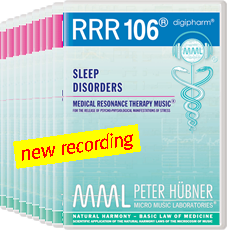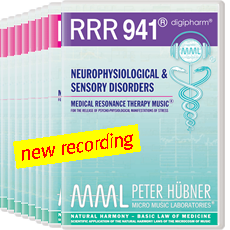| UNIVERSITY OF THE FUTURE |
| SCIENTIFICALLY INTRODUCING UNIVERSALITY TO THE UNIVERSITY |
Prof. Dr. med. Gunther Hildebrandt • Chronobiological Aspects of Music Physiology
Finally, let us outline one further musical aspect of rhythmic functional order in humans. On the one hand, we were indeed able to show that the features of a musical-harmonic order can be particularly intensified, when a person is sleeping. The stricter order of frequencies and phases of rhythmic functions and a simultaneous reduction to few spontaneous basic rhythms are obviously an important precondition for nocturnal rest and regeneration, as harmonic co-acting of all partial functions reduce the energetic demands to a minimum.
On the other hand, however, activity and demands on bodily functions during the day lead to this harmonic order dissolving and/or splitting up. This, however, happens in the three functional areas of the spectrum – as has already been shown – in entirely different ways (cf. illustration 20). In the area of the more complex metabolic rhythms, each rhythmic function has a whole series of pre-set harmonic frequency bands, in which the functions change into – depending on the demands put on them. From a musical point of view this is a series of overtones and/or undertones.
These rhythms in the metabolic area which are rich in overtones face rhythmic functions in the information system which show their level of activity through gliding frequency modulations, without preferring certain frequencies or letting them oscillate at the same time. These are, as it were, rhythms which are poor in overtones. And, on the other hand, in the average area of the respiratory and circulatory rhythms these two qualities of polar opposites penetrate each other.
If this analogy is permitted, one could assume an orchestra-like organization in the biological temporal structure of humans under the point of view of the tone color of various instruments. The woodwind players, poor in overtones, would be classified under the information system, the brass players and percussion instruments, rich in overtones, under the metabolic mobile system. The stringed instruments, very changeable in their tone color, would be in the center as a balance between the extremes.
Actually, such classifications have already been undertaken by e.g. BUEHLER (1976) and KOENIG (1969), following STEINER (1969) who had already characterized humans as an orchestra.
The investigation of the whole temporal organization in humans makes it clear that, besides the mentioned effects for all basic elements in music, adequate functional features can be found. Their consideration will considerably expand the points of view and questioning of music physiology and music therapy, as they are raised also by professional rhythmics. The methodical preconditions relating to this have already been studied to a large extent in modern chronobiology.
On the other hand, however, activity and demands on bodily functions during the day lead to this harmonic order dissolving and/or splitting up. This, however, happens in the three functional areas of the spectrum – as has already been shown – in entirely different ways (cf. illustration 20). In the area of the more complex metabolic rhythms, each rhythmic function has a whole series of pre-set harmonic frequency bands, in which the functions change into – depending on the demands put on them. From a musical point of view this is a series of overtones and/or undertones.
These rhythms in the metabolic area which are rich in overtones face rhythmic functions in the information system which show their level of activity through gliding frequency modulations, without preferring certain frequencies or letting them oscillate at the same time. These are, as it were, rhythms which are poor in overtones. And, on the other hand, in the average area of the respiratory and circulatory rhythms these two qualities of polar opposites penetrate each other.
If this analogy is permitted, one could assume an orchestra-like organization in the biological temporal structure of humans under the point of view of the tone color of various instruments. The woodwind players, poor in overtones, would be classified under the information system, the brass players and percussion instruments, rich in overtones, under the metabolic mobile system. The stringed instruments, very changeable in their tone color, would be in the center as a balance between the extremes.
Actually, such classifications have already been undertaken by e.g. BUEHLER (1976) and KOENIG (1969), following STEINER (1969) who had already characterized humans as an orchestra.
The investigation of the whole temporal organization in humans makes it clear that, besides the mentioned effects for all basic elements in music, adequate functional features can be found. Their consideration will considerably expand the points of view and questioning of music physiology and music therapy, as they are raised also by professional rhythmics. The methodical preconditions relating to this have already been studied to a large extent in modern chronobiology.
| MEDICAL RESONANCE THERAPY MUSIC® Medical Music Preparations on CD |
|
Listening Program: Sleep Disorders 
Listening Program: Neurophysiological & Sensory Disorders  |
|
If you like to look at the complete program, |